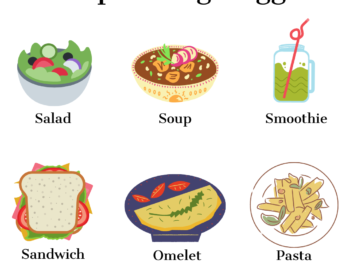Below is my blog post for Huffington Post, “Spring clean your diet with these 10 simple tips”
You can also read it here.

Along with a new season come new foods and rituals. One of the things I love most about springtime is the extra daylight. I try to take advantage of these longer days by taking a walk outdoors or biking in the park. I also love taking advantage of enjoying the seasonal produce available this time of year. From asparagus to berries, springtime is the season for healthy produce.
As a nutritionist, I am a big believer in working to improve our bodies along with our minds for optimal health. These 10 simple tips will help boost your health, and maybe even your mood, this season.
1. Make small shifts to your diet.
One of the key messages in the recently released 2015-2020 dietary guidelines is an emphasis on making small shifts to our diet, as opposed to radical changes which are often difficult to stick with. Think of a food habit you’d like to change and slowly ease into a new ritual by making a small shift. If you are a soda drinker, for example, shift your beverage to water or seltzer. If you tend to go hours without eating, plan for a healthy snack by bringing along an apple and a small bag of your favorite nuts. And most of us can make shifts in our diet to include more fruits and vegetables.
2. Mind your hand.
Paying attention the size of your portion is one of the best ways to keep your weight in check. While measuring your food can be a bit cumbersome and not always practical, using your hand is a simple and useful trick to help you guesstimate your portion. As I discuss in my book, The Portion Teller Plan, your portion of meat should be the size of your palm (approx 3 oz) and your side of rice should be the size of your fist (approx 1 cup.) While it’s not an exact science, as we all have different size hands, it is a helpful way to help gauge how much you eat. And if you have a bigger hand, you can probably get away with eating a bit more.
3. Get moving.
If you do not yet have an exercise routine, this is a great time to get one into place. Exercising regularly offers up many benefits — from helping us shed pounds, boost our moods, and even keep our minds sharp. In the springtime, we have the added benefit of great weather and more sunlight, a perfect time to get moving outdoors.
Research even shows that you exert more energy when exercising outdoors and you even may enjoy it more. Exercising outdoors may also help to alleviate stress and depression.
4. Swap multigrain for whole grains products.
Many of my clients are easily deceived by healthy sounding terms like “multigrain.” The term “multigrain” is defined as containing a blend of two or more grains and has little meaning when it comes to boosting your health. The grains may be healthy if they are whole rye or whole oats, for example, but they may also not be particularly healthy if they are a blend of enriched wheat flour, which is refined, and not to be confused with whole wheat. So pay attention to food labels and the first ingredient in your grain products.
5. Go green.
I am a huge fan of all things green, especially green veggies. Spinach, kale, broccoli, you name it, and if it’s green, it is most likely healthy! One of my favorite springtime produce is asparagus. Chock full of fiber, folate, vitamin K, and iron, asparagus is a nutrition powerhouse. I invite you to add asparagus to your springtime dinner routine. My favorite method of preparation is simply roasting it with a drizzle of olive oil and you are good to go.
6. Find hidden sugars lurking in your favorite food.
For the first time, the dietary guidelines call out added sugar, and advise us to limit our intake to no more than 10 percent of total calories. While we know that soda and candy are full of added sugar, we may not pay attention to the sugar lurking in our favorite salad dressing or whole gain cereal. Trying to reduce our sugar intake would be easier if every product that contained it called it “sugar.” However, so many food products on the shelves contain sugar yet call it by a different name. Be on the lookout for the following terms which are other names for sugar: sucrose, corn syrup, high fructose corn syrup, agave nectar, honey, dextrose, and evaporated cane juice.
The Food and Drug Administration has proposed a daily value (DV) for “added sugar” along with prominently displaying the amount of added sugar on the nutrition facts food label. This will hopefully clear up some of the confusion. But until that happens, be a food sleuth, and read the ingredient list.
7. Scoop it out.
We eat more out of large containers and when we pour out our favorite foods into a bowl or plate, we often pour too much. We also tend to overeat when we nibble right out of a jar or box of food. Consider your favorite cereal: pour it into an oversize bowl and you probably poured too much. Same with your favorite ice cream: eat a spoonful straight from a pint, and you may end up polishing off the entire container. A scoop or measuring cup to the rescue! Pour your cereal into a one-cup measuring cup or scoop, and you will hopefully stop right there. Use a half-cup ice cream scoop and it will be easier to stick to that portion.
8. Eat fat.
As a nutritionist, I advise clients to incorporate healthy fat into their diets. Healthy fats include olive oil, nuts, and avocado. Fats help us feel full so that we are not grabbing for that cookie an hour after eating. Nuts make for a great snack as they contain heart-healthy unsaturated fats, protein, fiber, and plant stanols. Just be sure to stick to one handful. Because fat contains more calories than carbohydrates and protein, practicing portion control is key.
9. Add strawberries to your favorite salad.
Strawberries are delicious and one of the lowest calorie fruits. They are also rich in nutrients, particularly vitamin C, an antioxidant which helps the body quench free radicals. In addition to tasting great plain (or with whipped cream, of course), strawberries will add color, flavor, and nutrients to your fruit salad or even your tossed green salad.
10. End your day with a grateful heart.
Giving thanks and practicing gratitude leads better sleep and improved mood.Research reveals that cultivating gratitude leads to better psychological and physical health. One ritual that I love recommending (and practice myself) is to write down 5 things I am grateful for each day. While certain things can always be better, we can all find a variety of things, both large and small, to be thankful for.
Photo complements freedigitalphotos.net by Rakratchada Torsap.



